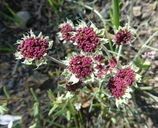Taxon Report
Lomatium hooveri (Math. & Const.) Const. & ErtterHoover's lomatium |
 © 2022 Zoya Akulova |
Taxon Summary
Lomatium hooveri, commonly known as Hoover's lomatium, is a perennial herb in the Apiaceae that is found only in California. It occurs within Chaparral, and Cismontane woodland, growing at elevations from 300 to 885 meters. Lomatium hooveri is ranked 4.3, Plants of Limited Distribution, A Watch List; Not very threatened in California.Classification
|
Scientific Name: |
Lomatium hooveri (Math. & Const.) Const. & Ertter |
|
Common Name: |
Hoover's lomatium |
| Family: | Apiaceae |
| Element Code: | PDAPI1B2K0 |
| USDA Plants Symbol: | LOHO3 |
|
Synonyms/Other Names: |
|
Ecology and Life History
| Lifeform: | perennial herb |
| Blooming Period: Apr-Jul | Apr-Jul |
| Elevation: | 300-885 (985-2905) |
| General Habitats: | Chaparral, Cismontane woodland |
| Microhabitat: | Serpentine, Volcanic (rarely) |
| Microhabitat Details: |
Conservation Status
| CA Rare Plant Rank: | 4.3 |
| Global Rank: | G3 |
|
State Rank: |
S3 |
| State List: | None |
| Fed List: | None |
| Other Status: | |
|
CRPR Changes: |
|
Occurrence Data from the CNDDB
| Total Occurrences: | 0 |
| Element Occurrence Ranks: | |
| Excellent (A) | 0 |
| Good (B) | 0 |
| Fair (C) | 0 |
| Poor (D) | 0 |
| None (X) | 0 |
| Unknown (U) | 0 |
| California Endemic: True | |
| California Counties and Islands: Name (Code) | |
| Colusa (COL), Lake (LAK), Napa (NAP), Yolo (YOL) | |
| Quads: Name (Quad Code) | |
| Detert Reservoir (3812265), Glascock Mtn. (3812283), Jericho Valley (3812274), Knoxville (3812273), Leesville (3912224), Lower Lake (3812285), Middletown (3812275), Salt Canyon (3912213), Walter Springs (3812263), Wilbur Springs (3912214), Wilson Valley (3812284) | |
Threat List Data from the CNDDB
| Threat List Total: | 0 | |
| EOs with Threat Listed: | Total EOs | % of EOs |
| 0 | 0 % | |
Selected References
|
Bulletin of the Torrey Botanical Club 69:153 (1942) |
|
Madroño 43(4):515-521 (1996) |
| Lomatium hooveri profile for potential Species of Conservation Concern evaluation (2018) |
Citation
California Native Plant Society, Rare Plant Program. 2025. Rare Plant Inventory (online edition, v9.5.1). Website https://www.rareplants.cnps.org [accessed 14 December 2025].